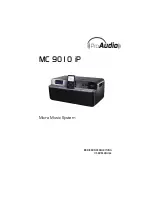
Revision A • 6/06
H
A
R
R
I
S
C
O
R
P
O
R
A T
I
O
N
2-2
2 Installation
Console Installation
The 99-5001 NetWave CD-ROM has
several video files on console installa-
tion; on installing optional items; on
setting up the console channels; and
on typical console operations.
GENERAL WIRING INFO
To facilitate console installation, create a wire
list of all console interconnections to and from pe-
ripheral devices. Identify and create tags for each
audio and logic cable. List these connections in a
master facility wiring logbook to ease installation,
future system wiring or equipment changes and
system troubleshooting.
Pages 2-18 to 2-22 cover wire preparation and
connector installation. Page 2-23 has block dia-
grams for the various NetWave logic connectors.
Pages 2-27 to 2-30 show typical peripheral con-
nections for a mic, a CD player, a computer play-
back system and linking to a VistaMax system.
Audio cables to/from the console should always
be run with the maximum practical distance from
all AC power mains wiring within the cabinetry.
The console’s 48-volt power cable carries only DC
voltage so audio wiring can run parallel or be tie
wrapped to this cable without problem.
The channel audio and logic wiring connects
sequentially along the back of the console in eight
channel groups. The chassis metal is cutaway be-
tween the DSP & I/O cards to facilitate getting
the connectors and wiring up through the coun-
tertop.
To ease installation, break out each group of
cables, using the dimensions shown below as mea-
sured from the right end of the cutout. Cabling is
normally broken out and tie wrapped to the bot-
tom of the countertop just behind the cable cut-
out. Leave a six to eight inch service loop on each
cable to ease installation and future wiring
changes. This extra cabling hangs down into the
cabinet (or the cable tray) after being connected.
The monitor and program outputs connect at
the right corner of the console along with the 48-
volt supply, the optional Link cable and the tech-
nical ground wire. The chassis is also cutout in
this area to ease installation.
Plug in all audio and logic cables first. Then
route the excess cabling (i.e., service loops) into
the cabinet by folding the audio and logic wires
over their connectors and arranging the cables to
go into the gap between the connectors and the
flip-up connector cover such that the cover sits
down onto the chassis behind the console display.
The technical ground wire, DC cable and any
Link and LAN cables can now be connected.
POWER SUPPLY PLACEMENT
Two types of power supplies are used with Net-
Wave consoles. Each has a single 48-volt DC out-
put using a keyed and locking connector. Each
uses an IEC AC input cable which is shipped with
a USA-type plug. The AC connector, or the IEC
CR AND STUDIO AUDIO & LOGIC OUTPUTS,
PGM BUSES & MIX-MINUS OUTPUTS,
EXT MON INPUTS,
TECHNICAL GROUND POINT,
48VDC SUPPLY INPUT,
LINK CONNECTOR
AUDIO INPUTS & LOGIC I/O
CH 1-8 (NETWAVE-24)
AUDIO INPUTS & LOGIC I/O
CH 9-16 (NETWAVE-24)
CH 1-8 (NETWAVE-16)
AUDIO INPUTS & LOGIC I/O
CH 17-24 (NETWAVE-24)
CH 9-16 (NETWAVE-16)
CH 1-8 (NETWAVE-8)
41" 28" 16" 1" 0"
Console Connections with Access Points (measured from the right end of the cable cutout)
















































